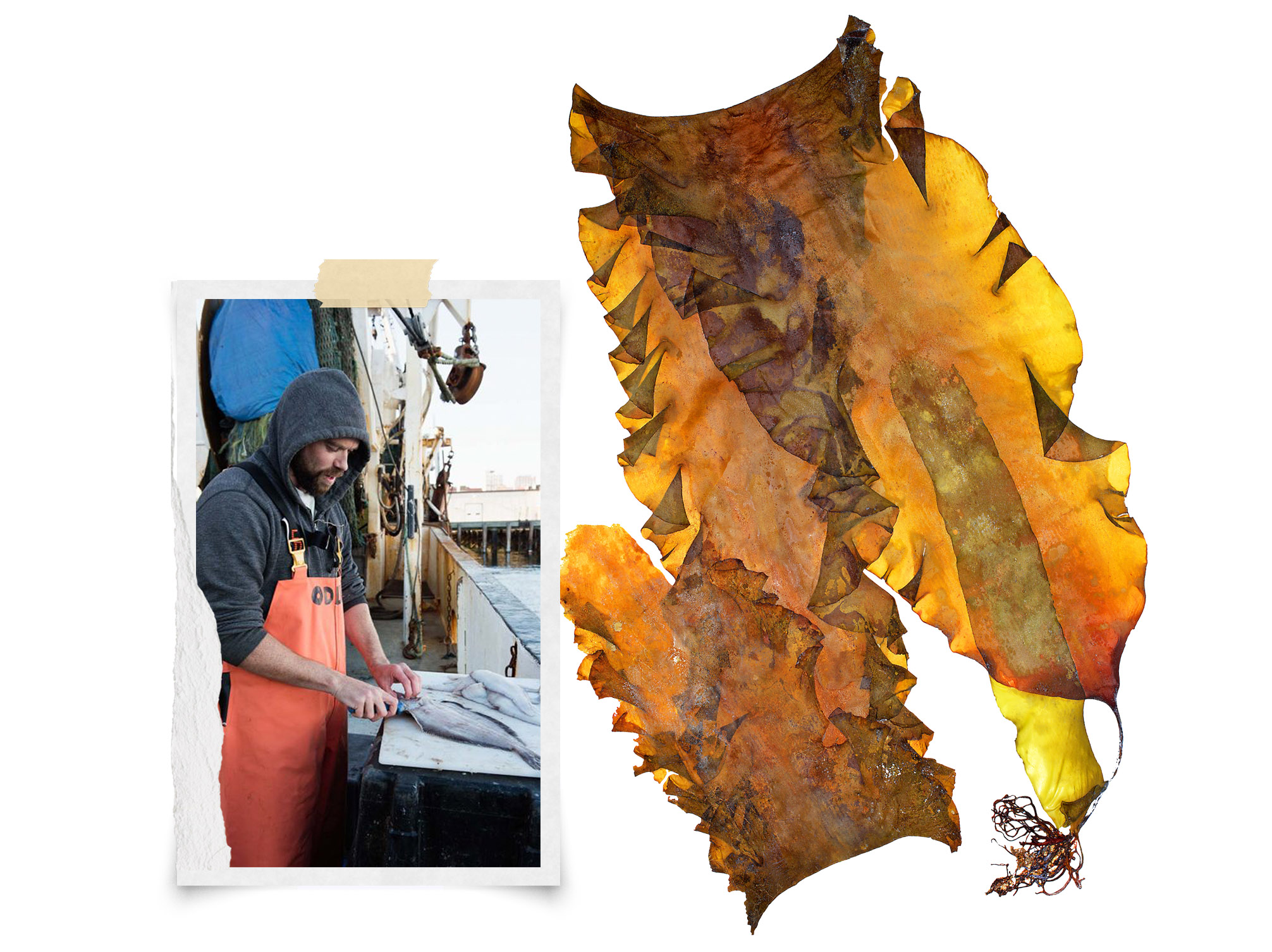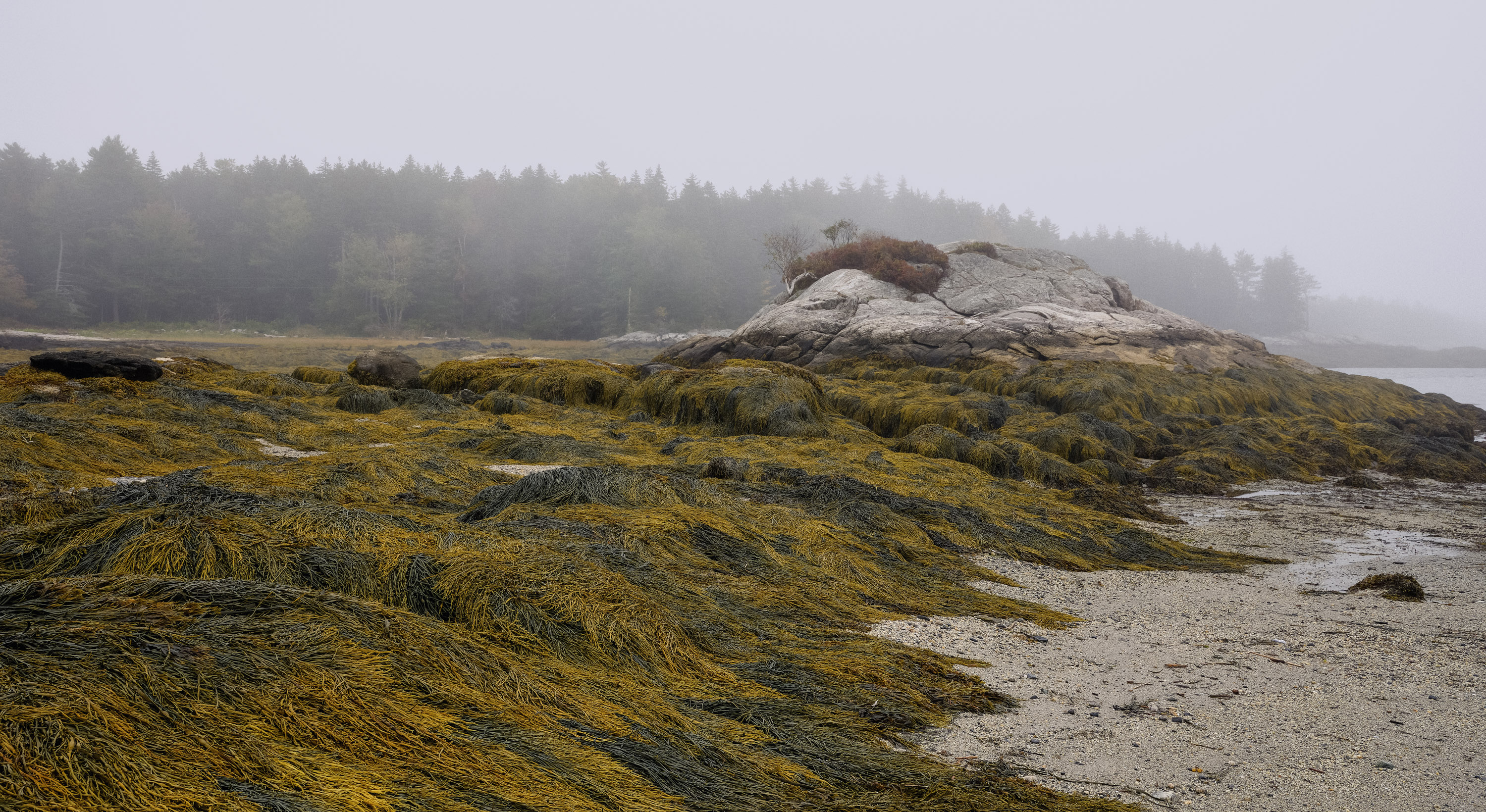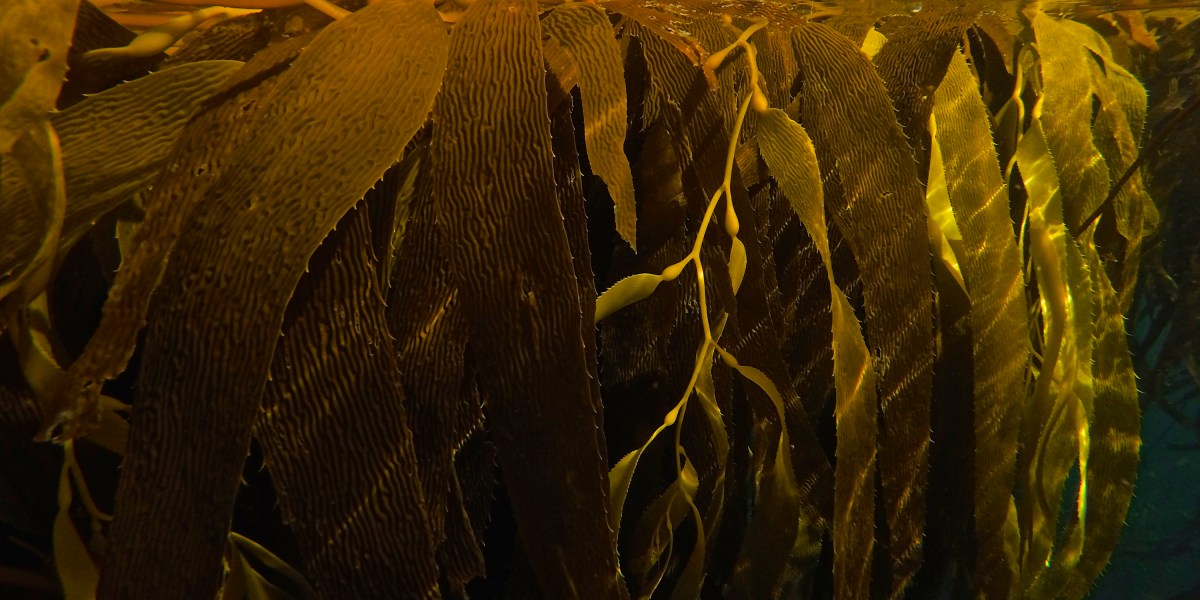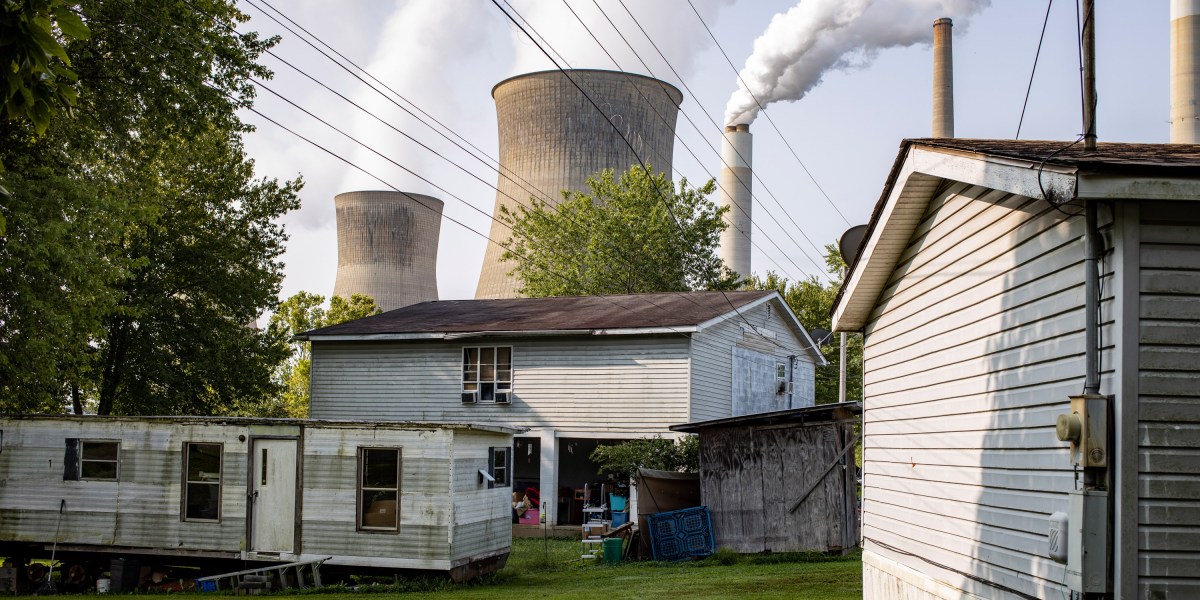Running Tide is facing scientist departures and growing concerns over seaweed sinking for carbon removal
Running Tide, an aquaculture company based in Portland, Maine, has said it expected to set tens of thousands of tiny floating kelp farms adrift in the North Atlantic between this summer and next. The hope is that the fast-growing macroalgae will eventually sink to the ocean floor, storing away thousands of tons of carbon dioxide in the process.
The company has raised millions in venture funding and gained widespread media attention, and it counts big names like the Chan Zuckerberg Initiative among its customers. But Running Tide struggled to grow kelp along rope lines in the open ocean during initial attempts last year and has lost a string of scientists in recent months, sources with knowledge of the matter tell MIT Technology Review.
At least several of the departures were due, in part, to concerns that the company’s executives weren’t paying sufficient attention to the potential ecological effects of its plans. Some employees were also disturbed that Running Tide was discussing more controversial practices, including adding nutrients to the ocean to stimulate macroalgae growth.
In a patent filing last year, the company described a floating apparatus that could be seeded with gametophytes or spores of macroalgae and “enhanced with a nutrient payload” that could “release iron oxide into the water.” That may amount to a form of ocean fertilization, a concept that sparked public criticism and prompted the creation of international regulations a decade ago.
In an interview and subsequent email, Running Tide CEO Marty Odlin stressed that the company has no current plans to implement the concept described in the patent filing. Further, he rejected the claim that the company isn’t taking ecological concerns seriously enough, and he disputed the idea that it had struggled in its initial field efforts and lost a notable number of researchers.
Running Tide is pursuing a lucrative though loosely regulated market: selling so-called carbon offsets to corporations. The hope is that growing and sinking more kelp or other sorts of seaweed will sequester additional tons of carbon dioxide that can balance out ongoing company emissions or otherwise help the world draw down some part of the billions of tons that may need to be removed to keep global temperatures in check in the coming decades.
Critics, however, fear that as more companies develop net-zero emissions plans, the public relations and financial incentives are pushing players on all sides of this market in a single direction: toward developing, funding, accrediting, selling, and buying as many carbon credits as possible, even if some of the practices have questionable benefits or could inflict environmental harms. A host of startups are pursuing a variety of novel ways to produce or sell the credits, backed by venture capital investments and hefty fees for each ton of carbon putatively sucked up and stored away. But a growing number of researchers and critics fear that some of the science is getting lost amid the carbon removal gold rush.
Running Tide’s ambitious plans, coupled with the loss of key scientists there, have raised particular concerns among some observers. Recent papers have posed a host of hard questions about the wisdom, effectiveness, and possible ecological dangers of growing and sinking kelp on the scales the company proposes. (Sources have previously said Running Tide aims to sequester 1 billion tons of carbon dioxide by 2025 and described its “hypothetical full scale” as a billion or more tons per year.)
Several seaweed experts and marine biogeochemists stressed in interviews that Running Tide’s interventions could harm highly complex, interconnected, and delicate ecosystems. Among other risks, the kelp could outcompete phytoplankton communities that already remove vast amounts of carbon and form the foundation of marine food chains that support global fisheries. In other words, it could harm global systems that already regulate the climate and provide crucial sources of income and food.
Philip Boyd, a professor of marine biogeochemistry at the University of Tasmania and lead author of an April perspective piece in Nature Ecology & Evolution that modeled the effects of Running Tide’s proposal, says that the field doesn’t have anywhere near the scientific knowledge necessary for companies to move ahead with these concepts.
“What we’re trying to do is blow some cold air into a debate that’s been done in a pretty cavalier fashion so far,” he says. “We’re not saying don’t do it. But if you’re going to do it, there’s a whole bunch of stuff you haven’t thought about yet.”
‘Speed of innovation’
Odlin said the company’s system and processes include numerous “safeguards and reviews … to minimize any possible ecological perturbations.” He adds that Running Tide is relying on the best science available and has continually consulted with numerous ocean experts.
He noted that the research group Ocean Visions had previously established an expert team to advise and evaluate Running Tide’s operations. The team, which included scientists from the Woods Hole Oceanographic Institution and the Monterey Bay Aquarium Research Institute, issued a report in 2021 that highlighted a number of potential environmental effects from various scales of seaweed sinking and provided guidance on future research efforts. Ocean Visions also announced the formation of an independent scientific advisory board for the company on June 8.
Odlin declined to comment on any specific personnel moves, but he insisted the company hasn’t seen an unusually high level of turnover for a five-year-old startup.
He said the company currently has 17 scientists, seven with PhDs, who have expertise in agronomy and ocean science.
“There’s a speed of innovation here,” he says. “This is hard work. And it’s not going to be for everybody.”
“I’m proud of the people we hired. Not all of them are going to work out. But that’s just part of this. I don’t think the data shows a remarkable turnover rate, I really don’t,” Odlin adds. “I think it’s actually remarkably low.”
He says, too, that restoring marine ecosystems damaged by climate change and other effects of human activity is a core mission of Running Tide.
“We’re doing this because we’re terrified by what we’re seeing,” he says.
Odlin, whose family has been in the commercial fishing business for generations, founded the company in 2017. The business says its aquafarming operations, which include producing shellfish, can help rehabilitate marine habitats. But Running Tide’s macroalgae-sinking plans have generated the most attention.

Interest in seaweed as a tool for carbon dioxide removal has surged in recent years as studies have found that the world may need to pull down massive amounts of the greenhouse gas, and that various types of macroalgae may naturally store away nearly 200 million tons of carbon a year already.
Much of the attention has focused on kelp, a large brown seaweed that can grow up to two feet a day. It mostly grows along coastlines, attaching itself to the rocky seafloor and taking up nutrients from the relatively cool, shallow waters. Through photosynthesis, it also rapidly absorbs carbon dissolved in seawater. Surface waters, in turn, draw down additional carbon dioxide from the air over the weeks to months that follow, restoring the balance between the oceans and atmosphere.
Running Tide and other companies hope to dramatically scale up this process by cultivating kelp or other types of algae on floats in the deep ocean. The idea is that locating the farms there means they won’t compete with other shoreline uses like maritime operations and ensures that more of the seaweed will end up on the seafloor.
Ocean circulation models suggest much of the carbon in biomass that descends into certain parts of the deep ocean could remain there for decades to centuries. A National Academies of Sciences report last year estimated that seaweed cultivation could remove around 100 million to 1 billion tons of carbon dioxide per year.
The company has said its free-floating microfarms could be seeded with kelp sporophytes and “mechanically rigged” to sink after six to eight months, ideally to below 1,000 meters (nearly 3,300 feet).
Shopify, Stripe, and the Chan Zuckerberg Initiative have all purchased future carbon dioxide removal from Running Tide, priced at $250 a ton in Stripe’s case. The company hasn’t disclosed its fundraising, but a PitchBook report notes it had raised more than $15 million as of this spring from Lowercarbon Capital, Venrock, Incite Ventures, and other investors.
“If we’re able to unlock growth in the open ocean, which we think is feasible, it has the potential to scale up to be quite big,” Odlin told MIT Technology Review last year.
But sources say early efforts to grow far beyond the coast didn’t produce much kelp.
Running Tide’s remote imaging system showed that the juvenile sugar kelp seeded on lines did grow in the ocean, Odlin said in an email, adding that to the company’s knowledge, this had not been achieved before.
He allowed that the “yield and consistency are not yet commensurate with that needed for large-scale carbon removal.” But he said the company didn’t expect that yet, and that some of the initial efforts were mainly focused on testing the company’s technical systems and deployment methods.
He and Justin Ries, senior scientific advisor at Running Tide, added that scientists already know kelp will grow in the open ocean, because there are varieties that do. They said the company will continue testing on small pilot scales until it identifies optimal species, locations, and conditions.
“No one said this was going to be easy,” Odlin says, noting that they’re working with complicated biological systems and a variety of macroalgae species. “Some are going to work really well; some are not; some are going to have huge variance … that’s part of the systems optimization that takes years.”
“This might take 30, 40 deployments to start to get traction and get this just right,” he says, adding that the company is still “a long way” away from any “significant deployment.”
Departures
Staff exits in recent months, according to LinkedIn, include Margaux Filippi, the director of ocean science; Raj Saha, senior data scientist; Olivia Alcabes, data research scientist; Jean Bertrand Contina, agronomy lead for macroalgae production; and Maxwell Calloway, senior kelp biologist. They either didn’t respond to inquiries or declined to comment for this piece.
Most of the researchers left after less than a year at the company and several after only six months, according to the career networking site.
Sources describe a company that’s driven by the need to begin earning carbon credits by sinking biomass of some kind into the ocean.
Running Tide executives have been dismissive of concerns raised about the potential impacts of these efforts, both by people within the company and by outside academics, these sources say. The executives, they add, minimized the downsides by asserting that addressing the urgent challenges of climate change will outweigh any possible ecological harms.
Odlin denied this.
“There has never been a specific ecological consideration raised by a member of our team that has not been seriously addressed and contextualized by our research department, our executive team, and discussed with external partners,” Odlin wrote. “We have a commitment to science and take seriously our stewardship of the oceans.”
Some outside experts think the early results described by sources may be indicative of larger challenges.
Boyd says it “really wouldn’t surprise me” that the company has run into issues getting kelp to grow in the open ocean. While there are “hundreds of species” the company could test in many parts of the oceans, most are adapted to the nutrient-rich waters largely concentrated along the coasts, he says.
He added there are other potential challenges and uncertainties around some varieties that do grow in the open ocean, like sargassum. A paper he coauthored last year in Nature Communications, using the massive sargassum seaweed bloom in the Atlantic in recent years as a model, concluded that seaweed farming in the ocean could even become a source of increased carbon dioxide. That’s because the seaweed competes for nutrients with other carbon-sucking species like phytoplankton, among other complex biogeochemical feedback effects. Also, crucially, it floats, so added measures or mechanisms may be needed to ensure that most of it reaches the bottom of the ocean.
Developing such systems and providing nutrients at sea could both add costs and complexity, and the latter could give rise to legal challenges and public pushback, as early ocean fertilization efforts did.
Running Tide’s patent filing describes one method in which a rope line could be “co-winded, coiled, and/or intertwined” with “iron or an iron-containing thread, filament, or string to … provide a source of iron (Fe) nutrient to the target product.”
The UN enacted a moratorium on ocean fertilization for commercial purposes more than a decade ago. That decision, which isn’t binding in itself, was driven in part by growing interest among businesses in the possibility of adding nutrients to the oceans to stimulate growth of marine species to suck down carbon dioxide.
In addition, nations that are party to the London Convention, an international maritime treaty that regulates ocean dumping, passed a resolution limiting the practice. Likewise, the parties to the London Protocol, which is supposed to eventually replace that treaty, passed an amendment restricting it. Though it has not been officially enacted, most nations have abided by the regulations to date.
Sources say the company has explored another, potentially faster way to begin sequestering carbon in the oceans: sinking significant amounts of wood chips or other forms of waste wood, possibly with smaller types of algae growing on them. This also prompted internal concerns over the potential ecological effects.
Odlin said there was “never a plan” to sink wood on its own and replied “no” when asked if the company has proposed adding nutrients to the ocean.
“If it becomes a part of the mainstream science playbook, we would consider it, but it’s not something that’s on our road map,” he said, adding later: “There’s no gotcha there.”
In response to a follow-up email that included a question about the patent filing, he wrote: “Running Tide has not prioritized meaningful operational development in this area. This is in fact an example of us respecting and trusting scientific consensus.”
“Some of the concerns that you raise seem to be rooted in decontextualized ideas that emerged during our open and inclusive early-stage, company-wide brainstorming events and thought experiments, where we consider without judgment the range of all possible ways to solve difficult challenges,” he wrote, adding that “there are many steps between potential ideas emerging from these brainstorming sessions and their implementation as a carbon removal strategy.”
Odlin said the company has long planned to use wood in some way in its kelp rafts, noting that it could also carry down the carbon in its biomass as it sinks. The company has recently explored using wood buoys that are coated in limestone, which may ease ocean acidification as well, as The Atlantic recently reported.
A ‘huge perturbation’
Oceanographers say that sinking significant amounts of wood could dramatically alter deep-water ecosystems.
In 2010, scientists at the University of Hawaiʻi at Mānoa and elsewhere sank more than 400 pounds of Douglas fir boards nearly 5,500 feet to the bottom of the Santa Cruz Basin, off the coast of California.
They found stark differences in the ecosystem when they went back in a three-person submarine over months and years that followed.
Wood-boring bivalves quickly set to work on the sunken material, followed by aerobic and then anaerobic bacteria that deplete oxygen and produce sulfide, respectively.
Opportunistic species that consume biomatter and can tolerate sulfides then crowded in, including hooded shrimp and bristle worms. But biodiversity “decreased significantly” as the water chemistry became toxic for other species because of the bacterial activity, says Craig Smith, a coauthor of the subsequent paper and a professor of oceanography at the university, who had no knowledge of Running Tide’s internal discussions or plans.
If such material were sunk on very large scales over years, significant stretches of the deep sea could become oxygen-depleted, microbe-dominated zones where little else could live, Smith says.
It would be a “huge perturbation to an ecosystem,” he says.
‘A major threat’
Researchers have pointed out numerous additional challenges in economically scaling up the natural seaweed carbon cycle into a massive, reliable form of greenhouse-gas removal and storage
For starters, reaching a big enough scale to significantly affect the climate will require dedicating a vast amount of ocean to seaweed farming. While Running Tide is targeting around a billion tons of carbon dioxide a year, the National Academies report noted that just removing 100 million tons annually could require the equivalent of a roughly 325-foot-wide belt of seaweed farms along more than 450,000 miles of shoreline. That’s equivalent to more than 60% of the global coast, and it would occupy an area nearly the size of Ireland.

It’s also increasingly clear that not every ton of carbon absorbed by seaweed can count as a ton of carbon removed. The oceans don’t necessarily suck up an equivalent amount from the air. Natural ocean mixing patterns might replace a significant amount of the dissolved inorganic carbon taken up by kelp, or shift waters away from the surface, among other factors that can come into play. As previously noted, the increased macroalgae growth can also come at the expense of other carbon-sucking species that rely on similar nutrients, which would need to be counted against any carbon removal attributable to seaweed.
Then there’s the question of where it all goes. Kelp continually sheds its blades and fronds as it grows. When kelp washes up on beaches, gets gobbled up by invertebrates and bacteria, or otherwise breaks down before it reaches the deep ocean, much of the carbon in it can simply wind up back in the air, says Catriona Hurd, a professor at the University of Tasmania who focuses on seaweed ecology and an author of a March study that highlighted the challenges of seaweed carbon accounting.
Companies “might sink a bit of carbon to the seafloor, but a lot of it will get broken down and remineralized along the way,” Hurd says.
More research is also required to know how much carbon stays sequestered, for how long, in varying locations and conditions, even when kelp does reach the bottom, she says. Indeed, considerably less carbon may stay in the deep ocean for 100 years or more than has generally been assumed, a study released this week from the UK’s National Oceanography Centre found.
Hurd says it’s not clear that farming and sinking kelp in the oceans will make “any difference to atmospheric carbon dioxide.”
“I don’t think so,” she says. “It’s my informed view that it’s not going to be a thing.”
Boyd’s Nature Ecology paper in April, as well as the Ocean Visions report, also listed a number of potential ecological problems with kelp sinking on large scales, beyond the possible effects on phytoplankton.
Large rafts of free-floating kelp could introduce invasive species and microbes. They would also cast shadows that might distort the behavior of deep-sea zooplankton and fish known to migrate upwards around dusk to avoid getting eaten.
As kelp piles up on the seafloor, it could choke off dense communities of species that live within ocean sediments. And it could attract and repel different creatures, altering the chemistry and biodiversity of delicate deep-water ecosystems.
“This is a major threat to the ocean’s biosecurity,” Boyd says. “We have no idea what happens when we scale this up.”
Boyd and Hurd both stress that the field is a long way from being able to create models that accurately estimate how much carbon will be stored through large-scale macroalgae sinking, which would be essential to any credible carbon offset market. They add that a rigorous, open, and extended scientific process involving teams of ecologists, oceanographers, and modelers will be required to better understand the complex interplay between these forces and to assess the benefits and costs.
Observers also note that while carbon uptake through tree planting and reforestation can be roughly estimated using on-the-ground spot checks or satellite images, it’s not clear how any accrediting organization could easily or affordably verify how much kelp companies are growing and sinking on free-floating rafts hundreds of miles out in the open ocean.
Odlin said the company is “probably building the most complete and robust quantification engine” for monitoring, reporting, and verification of ocean-based carbon dioxide removal, adding: “And we’re going to look to partners, to third parties, to validate that.”
Odlin said that Running Tide continually reviews new research in the field, internally and with its scientific advisors, to determine if any of it “changes the mainstream understanding of where the science is at with these earth systems,” he says. “And if it does, we’ll make an adjustment.”
But he suggested the company can’t respond or react to “every little paper that comes out from every person.”
“The overwhelming scientific consensus is that seaweed cultivation presents one of humankind’s most promising ocean [carbon dioxide removal] pathways, as asserted in last year’s National Academies report,” he wrote.
The report, which evaluated six marine-based carbon removal approaches, said there was “medium confidence” in the efficacy of seaweed cultivation. It rated the knowledge base as “medium-high,” scalability as “medium,” durability as “medium-high,” and environmental risk as “medium-high.”
The authors recommended a $125 million research program “to better understand overarching challenges for ocean-based CO2 removal approaches, including the potential economic and social impacts.” They estimated that $235 million will be needed to fund research priorities for seaweed cultivation over a five-year period.
‘Delivering tonnage’
Last October, Odlin tweeted about another startup that had announced it successfully removed 5,000 tons of carbon dioxide: “Ignore all the hype, tweets, concern trolling, conferences, fundraising, etc. One thing matters: Delivering tonnage.”
There’s broad agreement among climate scientists that in addition to slashing emissions, the world needs to figure out ways to begin rapidly drawing down vast amounts of carbon dioxide to address the rising dangers of global warming. How to do that affordably, reliably, safely and on massive scales remains a scientific question and a business challenge.
But some observers fear that a Silicon Valley mentality is taking hold in the carbon removal field, as climate concerns and financial rewards drive startups to rapidly test, tweak, pivot, and scale.
They stress that the urgency to solve this problem doesn’t free researchers, governments, or companies from the need to carefully evaluate the harms these concepts could impose and to establish appropriate rules governing the practices.
Added caution is required when it comes to the global commons that are the world’s oceans, researchers at Yale, Woods Hole Oceanographic Institution, the Environmental Defense Fund, and elsewhere warned in a perspective piece last month in Frontiers of Marine Science.
The authors called for the scientific field to adopt a code of conduct to guide work in marine-based carbon removal, stressing the lack of regulations, the unknowns in the space, and the potential for even just research “to effect tragic or unexpected outcomes.”
Odlin says that Running Tide is striving to address a critical societal danger, and doing its best to adhere to what the bulk of the science says.
“We are continuing to invest significant time and resources into agronomy, and still firmly believe that macroalgae can play an important role in durably removing carbon at climatically relevant scales,” he wrote.




